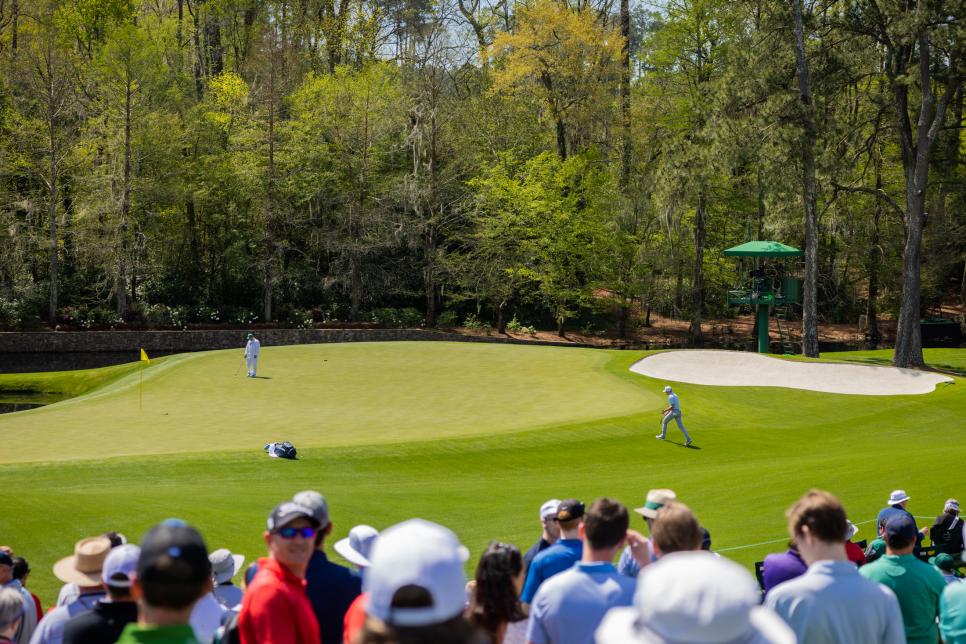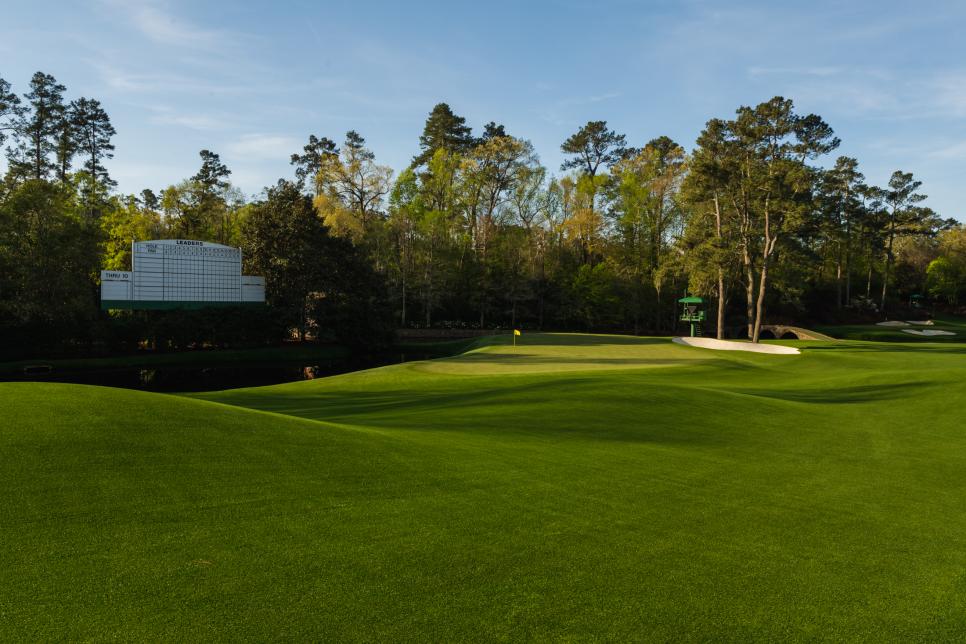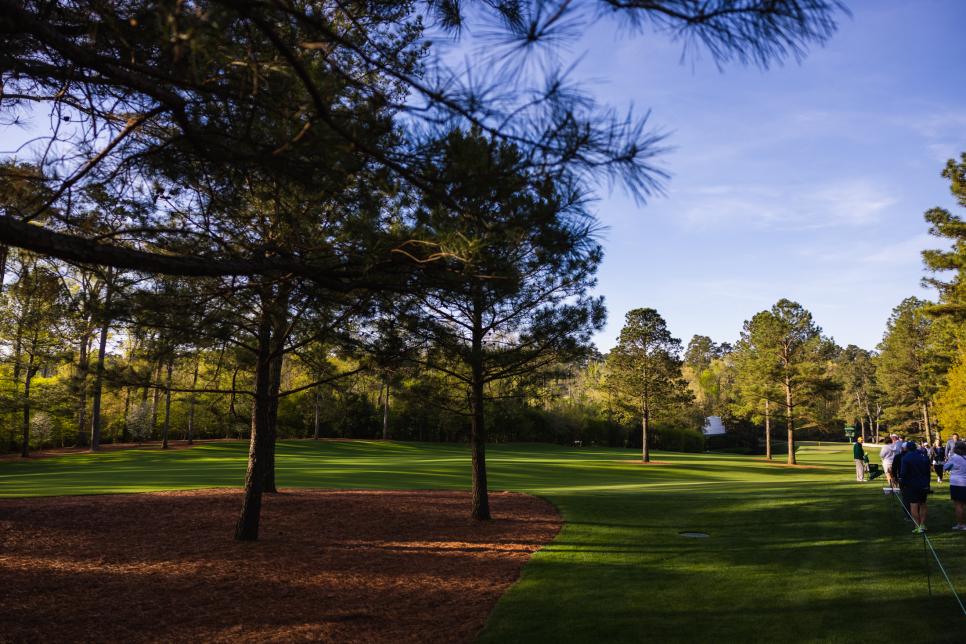Course Strategy
Masters 2022: It's more than extra length that's got players' attention on the new-look 11th and 15th holes

The surrounding area of the 11th green was signficantly changed before the 2022 Masters.
Ben Walton
AUGUSTA, Ga. — It is one of the most iconic moments in Masters history, but if Larry Mize faced the same shot today on the 11th hole at Augusta National that he did in the playoff on that Sunday in 1987, Greg Norman might own a green jacket.
To be sure, Mize’s deft pitch was phenomenal. From 140 feet right of the hole, he clipped the ball off a tight lie. It took two bounces before reaching the green and then rolled another 30-some feet, kissing the center of the flagstick while falling in.
If Mize hit that exact shot now, after significant changes were made to the 11th in advance of this week’s Masters, his ball would likely not have the steam to take what is no longer a bunny slope to the short grass. It’s a black-diamond shot now.
“We thought the Larry Mize shot was gone [before]. Now it’s really gone,” Tiger Woods said on Tuesday.
For all of its reputation to the contrary, change is a constant at Augusta National. It might not be so if the golfers were still using persimmon woods and balata balls, but the club has been forced since the arrival of Woods and his successors, because of their power and skill, to continue to examine every opportunity to toughen the test.
Tiger's takes on Augusta's course changes
Some of the alterations are subtle, like the way three greens—the third, 13th and 17th—have been recontoured for 2022. Others are far more noticeable. The par-4 11th was stretched 15 yards to 520, actually making it longer by 10 yards than the par-5 13th. In addition to the length, a couple of dozen trees on the right side were removed and the aforementioned green surround was hallowed out on the bail-out area to the right.
At the par-5 550-yard 15th—which has become a two-shot hole for even modest-length drivers—the tees were moved 20 yards back, to a spot that is now almost directly behind the 10th green. A sizeable number of Holly trees were placed on the right side of the tee, and the fairway has been reshaped to feed balls more to the center if the tee shot is placed properly.
Beyond some players who made trips to Augusta in the buildup to the season’s first major, others were seeing the changes for the first time early this week. For a constituency that rues surprises, they seemed rather impressed.
The most talked about hole is 11, which has played as the second-toughest hole, behind the 10th, in Masters history. To start Amen Corner, the tee shot is uphill and blind and the approach is the picture of precision, with the pond on the left and a bunker deep on the right. Ben Hogan was the man who said if he you saw him find the green with his approach at 11, he’d mishit his shot. His preferred miss was the then-relatively flat spot to the right of the green.
“I think 11 looks amazing. I think it's a great change,” said 2013 Masters champion Adam Scott. “The look of the fairway looks great, but the big play difference, in my opinion, is missing the green right has gotten a lot worse now. So that's going to be an interesting one. That's a very, very demanding second shot, which I think is super around that stretch of the course.”

A look from the fairway to the 11th green.
JD Cuban
In practice rounds, players have spent a lot of time examining and testing the new slope at 11. They try the putter. They try a wedge. They scratch their head. On Monday, Jason Kokrak attempted a half dozen chips from off the green; only half of them found the putting surface.
“That dropoff on the right side is significantly deeper than it used to be,” Rory McIlroy said on Tuesday. “So, the miss really now is short right, sort of front edge, level with front edge of the green and just a little right. But that brings those mounds into play.
“Then, what people probably don't realize is that pond on the left has been extended another 10 yards back towards the tee. So that pond used to start at the front of the green. That pond now starts 10 yards before the green. So now it brings in those mounds and the water. So the penalty for missing that second shot is much greater, and then if you do miss it, obviously it's a very, very difficult up and down from there.”
The other big change at 11 is the removal of a cluster of trees in the right driving area. The mature pines seemingly “grew” overnight before the 2003 edition, an obvious example of “Tiger-proofing” after Woods won back-to-back Masters. And from that cluster the famous shot in 2007 when Woods found himself behind a tree and snapped his 4-iron while wrapping it around the trunk.

The removal of trees on the right side of the fairway at No. 11 has opened up space for players to drive it right and still have a shot at the green.
Ben Walton
Now, there are only three strategically placed pines on the right, allowing even a modestly pushed drive to end up in a gap that would afford a shot at the green. McIlroy, noting that the fairway is 50- to 60-yards wide, called it a “slightly less daunting” task off the tee.
“It was always an awkward tee shot,” he said. “You had to hug that right side, and then if you just got it slightly right, you were in those trees. And you had to be very fortunate to have a shot to the green unless you blew it way right into that sort of alleyway where people walk.”
By contrast, the 15th has been one of Augusta’s most inviting and most exciting holes. Historically, it’s played as the second easiest, behind the par-5 13th, and it’s the scene of so many back-nine heroics and flameouts on Sundays. But with the distance boom, going for the green in two was nearly automatic after a good drive. The days seemed gone that anyone would replicate Zach Johnson’s four layups in his 2007 Masters win.
Thus, the added 20 yards, which still only makes the hole 550 total, but they’re running out of real estate.
“We were getting to a point where we're hitting 7- and 8-irons, 9-irons in there [on second shots], especially on the firm year,” Marc Leishman said. “You don't want to be doing that to a par 5. You want to be for your score, but if everyone's doing it …”
The question is: Can 20 yards really make a difference these days? It depends on the player.
“Going to play a little different for me. I think I went for it every day last year,” said Brian Harman, who ranks 162nd on the PGA Tour in driving distance with a 290-yard average.
Said Lee Westwood, another player who averages less than 300 off the tee: “It certainly makes you think now. Even if you hit a good drive, it's not an immediate ‘yes, I'm going to go for it.’ I hit a good drive down there yesterday, it was a little bit into the breeze, and I had 267 flag. That's a normal 3-wood for me, and the firmness that the greens are at … I'm landing on that green and it's tough to stop it.
“It's really a juggling act and an evaluation of whether it's easier to hit a 100-yard pitch shot into a green that's sloping slightly against you than it is a 20-yard through the back with it running away from you towards the water. It certainly makes you think.”
It's the examination that Augusta has always seemingly strived for: mind over might.
More Masters 2022 stories from Golf Digest